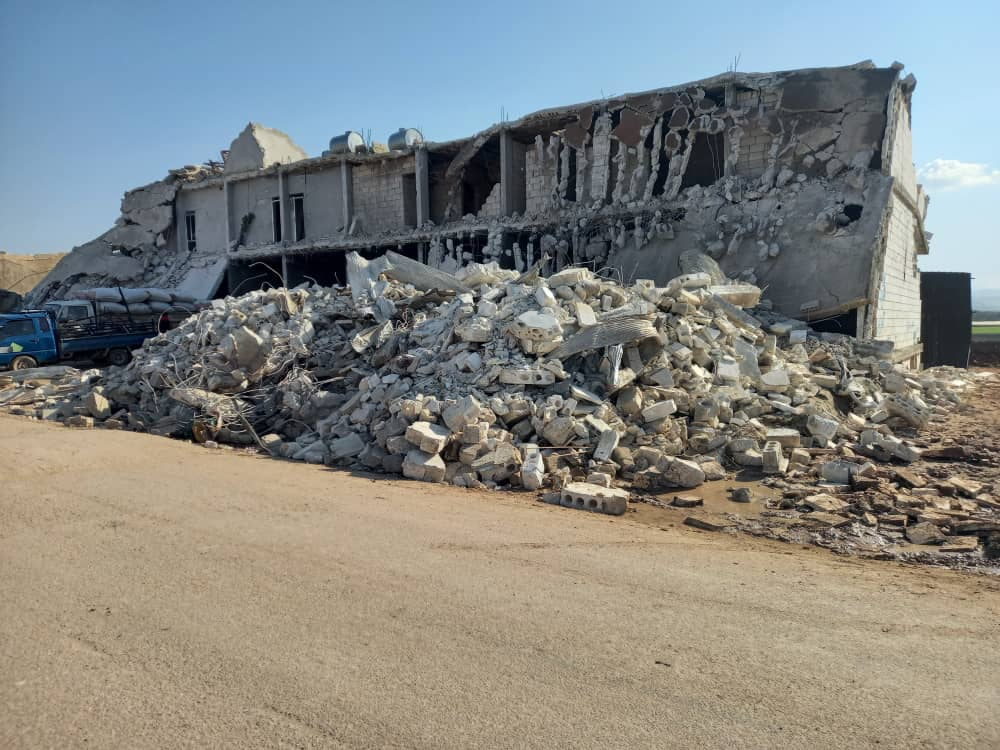
Volume 7
Northwest Syria Series
Obstacles to post-earthquake rehabilitation
October 2023
Introduction
The February 2023 earthquakes in northwest Syria led to widespread destruction as thousands of people were forced to evacuate and seek shelter elsewhere. Estimates by the Shelter Cluster reveal that: (i) 265,000 individuals (approximately 53,000 households) lost their homes completely due to severe damage, (ii) 225,000 other individuals (approximately 44,000 households) reported their homes sustaining moderate damage, (iii) while 632,000 others (approximately 126,000 households) reported their homes sustaining minor damage. In addition, approximately 1,900 buildings collapsed entirely, and over 9,000 faced partial destruction. Given these numbers, there is an immense need for support to repair and rehabilitate structures.
Despite the massive scale of destruction, rehabilitation efforts in northwest Syria have yet to gain traction, particularly when it comes to addressing severely damaged homes. According to shelter experts, properties with damage are generally classified into three categories:
● Minor damage: Structurally sound properties with damage such as cracks to surfaces and/or openings;
● Moderate damage: In general, structurally sound properties with sustained damage such as ruptures to non-load-bearing walls;
● Severe damage: Properties that have sustained serious damage to pillars or foundations, they are not fit for occupation and require reinforcement and structural stabilization. If not rehabilitated in a timely manner, they can become at risk of demolition.
For the time being, humanitarian actors continue to focus on quick fixes for homes that have sustained minor or moderate damage, rather than long-term rehabilitation. This can be understood as part of humanitarian actors’ emergency response plans to cover urgent needs first. In addition, these endeavors require less financial support and technical know-how compared to rehabilitating severely damaged homes. Longer-term rehabilitation efforts tailored for severely damaged homes and buildings have yet to materialize at scale due to financial, technical, but also legal and political barriers tied to the nature of the protracted conflict in Syria.
In this seventh report in the Northwest Syria Series, Crisis Analysis–Syria (CA–SYR) unpacks the barriers hindering rehabilitation at the humanitarian response, grassroots, local authority and community levels. We navigate the challenges faced by international and local actors, policy and governance barriers, as well as coping mechanisms homeowners resorted to in light of delayed support. We conclude with the broader implications for future rehabilitation efforts in northwest Syria’s earthquake-affected areas.
Key findings
I. At the humanitarian response level, rehabilitation works have remained focused on minor to moderate damage, while severely damaged buildings have yet to be addressed:
Post-earthquake rehabilitation efforts in northwest Syria have focused on quick fixes and restoration rather than long-term reconstruction, partly due to funding limitations and technical challenges, coupled with strategic ambiguity in the humanitarian response.
There are no concrete plans to reconstruct severely damaged homes due to funding shortages, resource constraints, and a lack of technical expertise for structural assessments. There is also confusion among humanitarian actors about whether such efforts fall under humanitarian or development mandates.
Coordination challenges among INGOs, UN agencies, and local authorities, along with complex funding mechanisms, are hindering the clarity and commitment needed for long-term rehabilitation efforts, potentially leaving residents responsible for recovery in the face of capacity shortfalls.
The adoption of the cash-for-rehabilitation approach has expanded the reach of recovery efforts, accelerating response, increasing ownership, and fostering participation. These innovative methods can serve as a foundation for assisting severely damaged homes in later stages of the response.
II. At the grassroots level, local and international crowdfunding initiatives have provided flexibility but were limited in their longevity and overall effectiveness:
Due to limited funding and extensive shelter needs following the earthquakes, the rehabilitation of severely damaged properties in northwest Syria partially relied on local and international crowdfunding initiatives, despite their limitations in terms of short-term funding and geographical reach.
These crowdfunding initiatives, along with local organizations and private fundraisers, highlight the significance of community-driven efforts, which allow more flexibility during emergency responses.
III. At the local government level, post-earthquake policies have provided some flexibility for residents to rehabilitate their homes but were still obstructed by financial and planning constraints:
In the aftermath of the earthquakes, local authorities in northwest Syria made efforts to assess damages and adjust policies to facilitate rehabilitation, including providing free building permits and tax exemptions for quake-affected areas.
In Aleppo, a policy shift has made building permits free, leading to a more flexible landscape. Properties requiring minor renovation without structural changes no longer need permits. However, the unregulated construction environment in rural areas raises concerns about reconstruction quality, public safety, and housing rights.
In Idleb, residents affected by the earthquake or conflict were exempted from various fees by the Syrian Salvation Government's Ministry of Local Administration and Services. However, financial constraints remain a significant obstacle to rehabilitation efforts. Political complexities, ongoing clashes, and competing geopolitical interests also complicated reconstruction efforts.
IV. At the community level, some homeowners and local communities had to adopt their own coping mechanisms to complete the rehabilitation of their homes:
Households in northwest Syria facing structural damage reported inconsistent aid from various entities, making it challenging to standardize rehabilitation efforts.
Homeowners in Aleppo expressed disappointment due to unmet promises by organizations and local authorities, while the rehabilitation process was delayed as it depended on evaluations by an engineering committee, leaving residents waiting for necessary surveys and permissions.
Northwest Syria has also been struggling with rising inflation and price hikes due to currency devaluation and economic instability, which began before the earthquakes. Residents reported exorbitant prices for construction materials and labor posed significant obstacles to their personal rehabilitation efforts.

